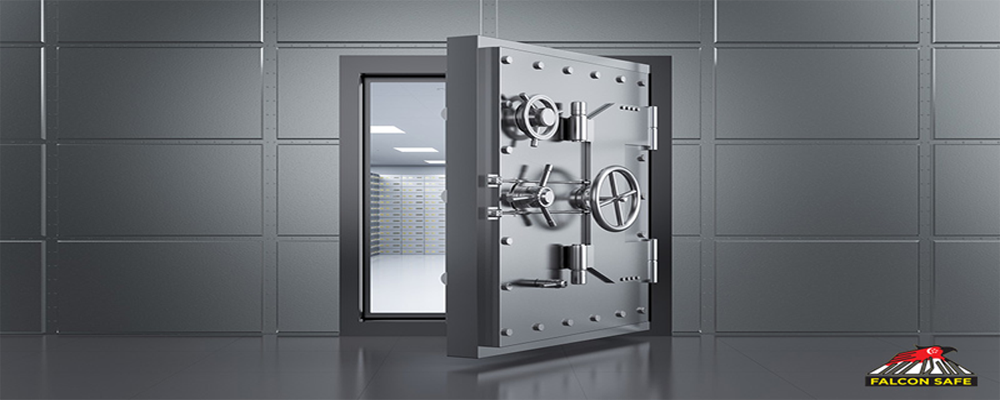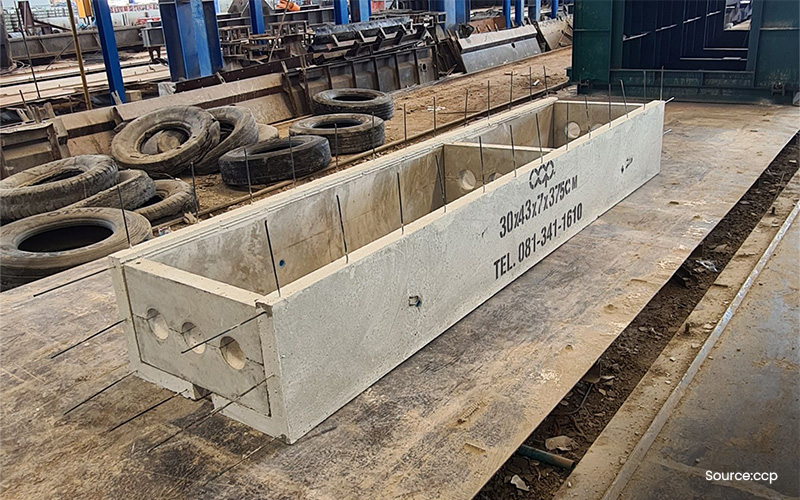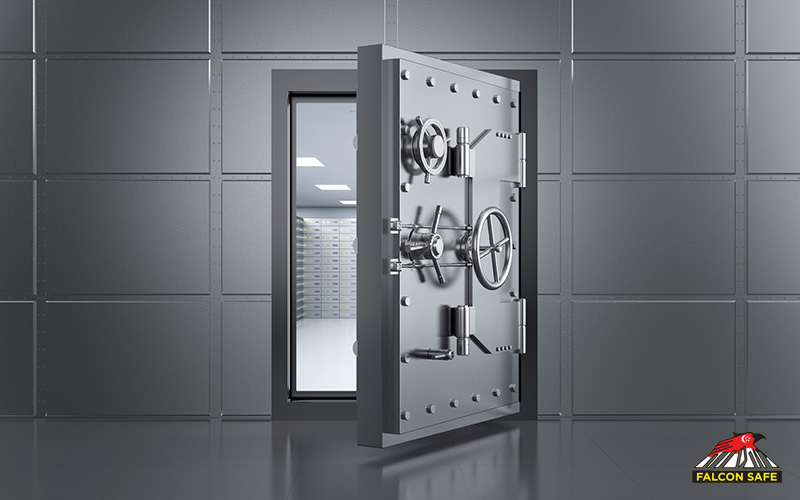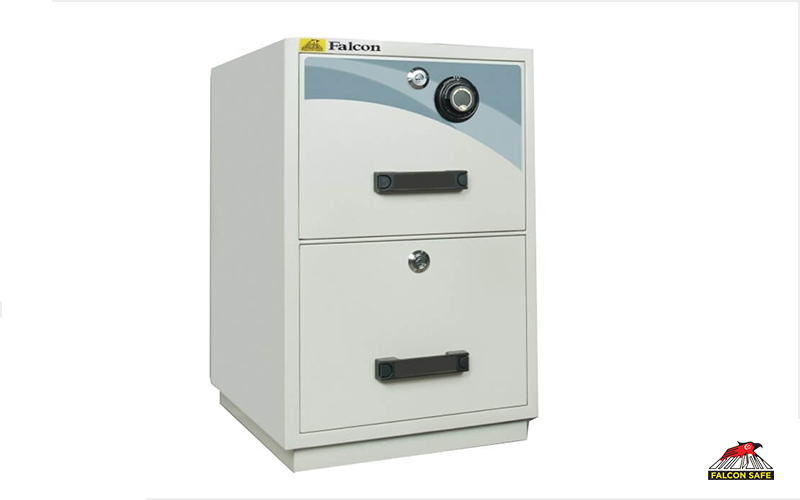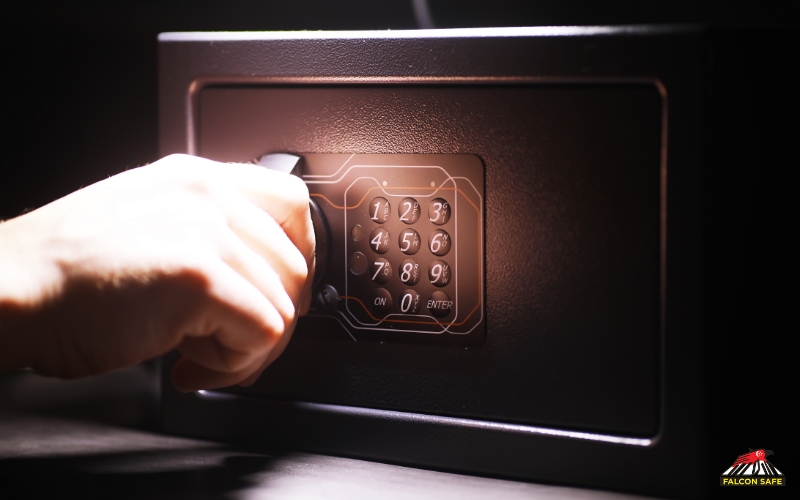PART 1 – INTRODUCTION
Safe rooms provide you near-absolute protection against extreme weather like hurricanes and tornadoes, as well as invasion of intruders. The “shelters” are usually built in a house for easy accessibility, in case of an emergency. Typically, safe rooms are made of reinforced concrete, reinforced concrete block or wood-framed walls, to name a few. They are “shielded” with a similar structural ceiling or roof that stands alone from the house structure. To withstand the uplift forces produced during extreme weather, everything is tied down to the foundation from the top of the safe room. Occupants will be protected from wind-borne debris, thanks to the impact-resistant exterior materials and structure of safe rooms.
On the other hand, vault rooms allow you to secure your valuables such as emergency cash, important documents and jewellery. They are built with thick concrete walls and secured by a sturdy metal vault door. Power generators, ventilation systems, firearms and other additional features can be found in most vault rooms. A vault room is commonly used by risk industries such as logistics, banking, pharmaceutical and retail to safeguard the most valued properties on premise. This article will share everything about safe rooms and vault rooms. Read on to learn about their differences, functions and more.
PART 2 – GETTING TO KNOW SAFE ROOMS AND VAULT ROOMS
2.1. How to build an ideal safe room and vault room?
A safe room is a reinforced area in your house that can protect you against hazards. It is typically constructed onto an existing home or built as part of a new home. Meanwhile, a vault room is built with thick concrete walls and complemented with a very secure vault door. Refer to the list below to find out what you should consider when building a safe room and vault room.
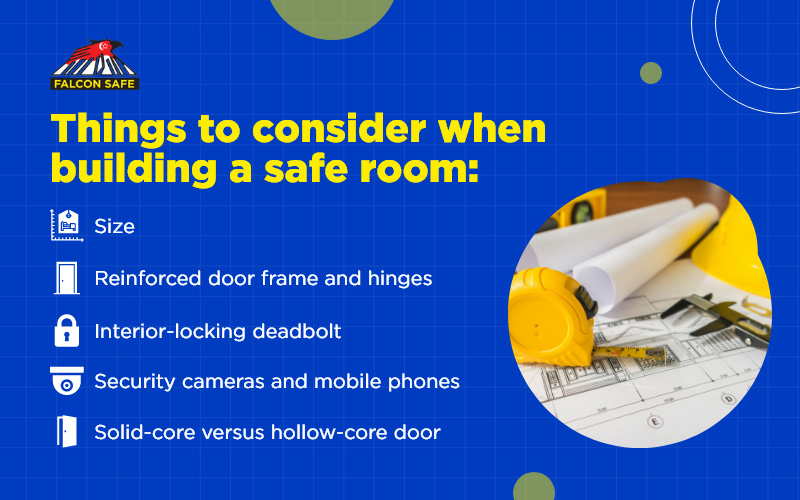
- Things to consider when building a safe room:
- Size
The size of a safe room should be large enough to accommodate the whole family.
- Reinforced door frame and hinges
It is advisable to use a reinforced steel frame for your safe room for additional security, apart from screws that have a minimum length of 3 inches in the hinges and strike plate.
- Security cameras and mobile phones
It is crucial to keep a mobile phone and charger in your safe room at all times. You would need them to contact the authorities for help in case of an emergency. Also, installing security cameras allows you to monitor the exterior view. As quick action is important during invasions, installing an alarm system is a must as well. An alarm system provides immediate alert when security is compromised. This is made possible as alarms consist of a series of electrical components linked to a property. When movement such as opening of windows and doors is detected via sensors and contacts, a loud alarm is triggered to alert people about the unauthorised entry.
- Interior-locking deadbolt
A heavy-duty reinforced deadbolt should also be installed in your safe room. Make sure the deadbolt is at least one-inch into the door frame. In addition, avoid placing a keyed chamber on the outside of safe room doors.
- Solid-core versus hollow-core door
An ideal safe room should be complemented with a solid-core, exterior steel slab door to prevent break ins. Some owners may choose to camouflage their safe room door by having it painted the same colour as the surroundings.
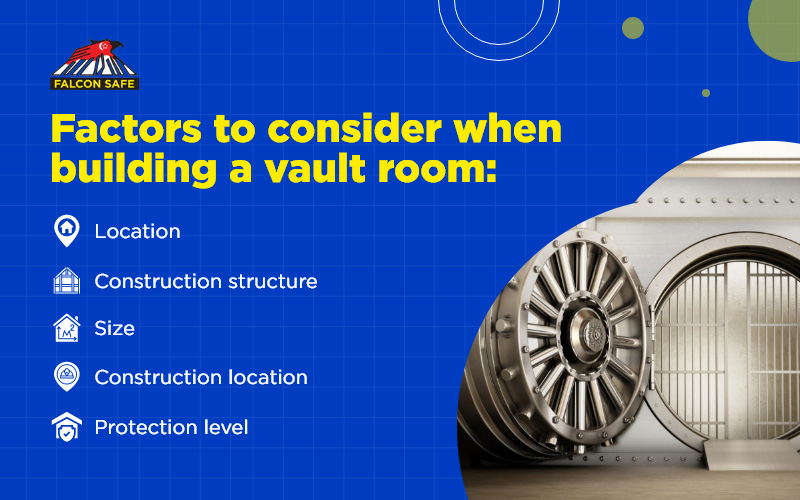
- Factors to consider when building a vault room:
- Location
Selecting a location to build your vault room requires thoughtful consideration. Privacy may be compromised if a vault room is too central. However, installing one at a location that is too remote makes it hard to seek assistance. The best spot is at the edge of the city as it comes with accessible transportation.
- Construction structure
A vault room can be built with a hexahedral structure, or pentahedron structure, if there is concrete with above 200 mm on the ground. Z-shaped vents are constructed at the top, while H-shaped steel columns and beams are built inside the warehouse. If there is sufficient budget and construction space, formwork and concrete pouring can be considered as well.
- Size
Measure the height, width and length of a modular vault room before asking your vault manufacturer to provide one. This ensures a more seamless installation process with proper storage size accommodation.
- Construction location
The warehouse and basement are ideal locations to house a vault room as there is no need to worry about load-bearing issues on the ground.
- Protection level
In general, vault rooms and doors are categorised in certification and non-certification types. For the certified ones, Underwriters Laboratories Standards, or UL Standards, serve as a benchmark that determine the security levels, encompassing the burglary resistance standards set forth by the UL. The certifications range from Class M to Class 3. There are UL 608 Burglary Resistant Modular Vaults and Vault Doors, and UL 680 Standard for Emergency Vault Ventilators and Vault-Ventilating Ports.
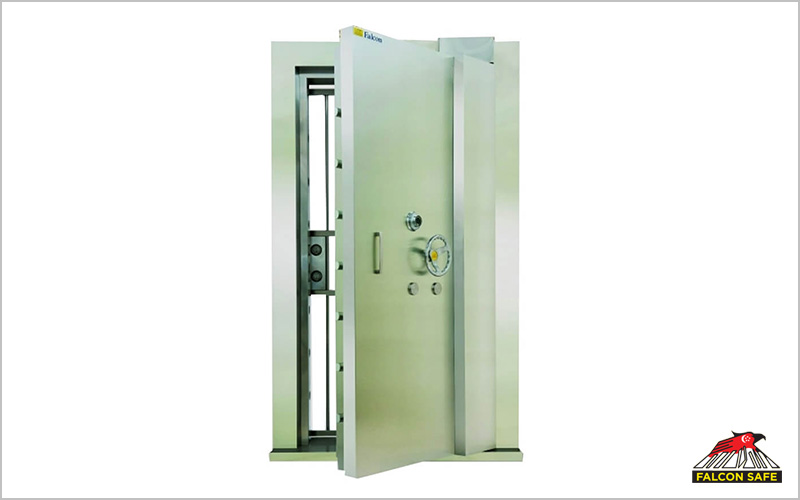
2.2. Recommended equipment and supplies in a safe room
A solid, metal safe door acts as the first layer of protection for a safe room. To further strengthen security and enhance comfort levels, certain necessary equipment and supplies should be placed in a safe room. Here are some recommendations for each category:
- Surveillance
Security cameras are key for surveillance purposes, including monitoring the safe room’s exterior. Set up monitors and connect them to the cameras to allow for supervision.
- Power
Generators must be self-contained in safe rooms for power supplies. You may use battery-powered or hand-cranked lights and phones in a basic safe room. Nonetheless, ventilation, and carbon monoxide poisoning are two concerns that require more attention.
- Communication
During an emergency, communication plays a huge role in ensuring safety. Therefore, a mobile phone should be installed in a safe room to seek assistance and rescue. In addition, it is advisable for those who have an isolated safe room to install a buried phone line, an intercom system or an alarm button with direct connection to police and other authorities. A strong room door is undoubtedly one of the key elements for protection but adding soundproofing features to your safe rooms is a merit as well. This prevents an intruder from hearing your conversations with law enforcers.
- Supplies
Daily supplies such as food and water are necessary in a safe room. This helps occupants survive through an attack. It is also best to build airtight, temperature- and humidity-controlled chambers, as well as air-filtration systems for protection against biohazards. First aid equipment and oxygen masks should be prepared as well.
2.3 All about Eurograde Safes
Eurograde safes are safes tested to the European burglar resistance standard, or EN 1143. The zero to six Eurograde rating system is meant for safes that are built to prevent theft and burglary. The amount of cash to be protected determines the grade. Firstly, these safes are required to pass different detailed testing performed by national testing agencies. The rating will only be applied then. A Eurograde rating is assigned once the test is completed and the resistance level of the safe is identified. The length of time to break open a safe determines its resistance level. Seek professional advice from safety deposit box manufacturers if you wish to know more about the Eurograde rating.
2.4 What is a bank vault?
A bank vault refers to a secure space to store valuables, records, cast and documents. Vaults usually come with armoured walls and a high-security door to protect the contents. Modern vaults may be equipped with anti-theft devices, alarms and other security equipment, as well as advanced security technology to defend against intruders. Compared to the past, vaults nowadays are built with thinner, lighter materials, without compromising the level of security.
- The manufacturing process
Step 1: The wall panels are moulded.
Step 2: A network of reinforcing steel rods are placed into the damp mix.
Step 3. The moulds vibrated for several hours.
Source:ccp
Step 4: The edges are smoothed and the concrete is allowed to harden.
Step 5: The product is unmoulded and the panels are to be transported by vault suppliers to the customer’s construction site.
Step 6: Usually, a dual-control combination lock will be installed.
Step 7: The built vault panels, lock assembly and door are sent to the bank construction site.
Step 8: The panels enclosed in steel are placed at the designated spots for welding.
- Quality control
Underwriters Laboratory, Inc. (UL) oversees quality control of the vault industry. Today, the effectiveness of the vault is measured by its defence level against a mock break-in. Listed below is the time taken for each class of the bank vaults to withstand a break-in attempt:
UL Class 1 vault: to withstand a break-in attempt for 30 minutes
UL Class 2: to withstand a break-in attempt for 60 minutes
UL Class 3: to withstand a break-in attempt for 120 minutes.
Meanwhile, vault manufacturers also conduct testing when designing a new product to ensure it passes the UL trials.
- Waste
No unusual waste is produced during the manufacturing process of bank vaults, but getting rid of old vaults can be challenging. Massive wrecking equipment is required to demolish vaults and it takes months to complete. Fortunately, newer, modular bank vaults can be enlarged or relocated easily.
- Five interesting facts of bank vaults
- Used to keep unusual and unexpected items.
- Can be repurposed as they are hard to destroy.
- Stuck with a type of innovative lock
- In ancient times, bank vaults were built to last forever
- Joining a technological arms race with burglars
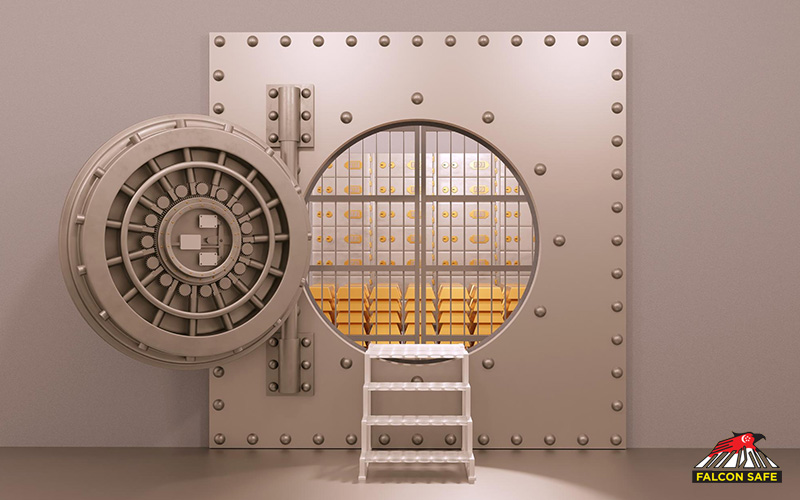
PART 3 – ENTERING THE WORLD OF SECURITY
3.1 Introduction to vault doors
Vault doors offer special custom and good anti-theft performance, thanks to their stable shape, door lock and heavyweight that enhances safety. On top of that, the metal-made doors are also highly resistant to fire and damages.
- Basic mechanism of a vault door
Typically, a vault door is made up of the following components:
- The door frame
- The day gate
- The door leaf
- The key lock
- The mechanical code lock
- The actuator of the lock
- Installation of devices/equipment
To build a strong room door, addition of security means is essential. Often, a vault door is equipped with time locks, alarms, automatic lighting systems, electronic code locks, waterproof devices and any others as needed. To ensure better safety performance, some consumers will opt for fingerprint readers and iris recognition, among other biometric devices.
- Classification of vault door protection level
Rating M: 15 minutes anti-destruction time
Class 1: 30 minutes anti-destruction time
Class 2: 60 minutes anti-destruction time
Class 3: 120-minute resistance time
3.2 Notable aspects about vault doors
Breaking a vault door is not easy because it is constructed with strong material. With special and sophisticated locks, the breach becomes even harder. Meanwhile, the weight of a bank vault door is pretty much dependent on the size and type of steel it is made from.
- To open a vault door
Step 1: Key in the correct combination of numbers.
Step 2: The lock will then release.
Step 3: You will be allowed to access whatever is stored inside the vault.
- Tips to purchase a vault door
When buying a vault door, ensure that it is equipped with thick solid steel. You may also want to ponder over the right weight, ease of entry and vault door relockers to meet your requirements. Remember, it is also crucial to consider a vault door that is installable in an accessible location.
3.3 Unveiling a safety deposit box
A safety deposit box is an individually secured container commonly seen in the safe or vault of a federally insured bank or credit union. It can be used to safeguard valuables, important documents, and other keepsakes. Safety deposit boxes are usually used to store important items that are not frequently accessed, including school transcripts, personal papers, contracts, business papers and records.
- How do safety deposit boxes work?
When you rent a safe deposit box, you will be given a key by the bank to access the box. Otherwise, you will need to scan your fingerprint, if a keyless system is adopted. Generally, some type of identification is required before you can open a safety deposit box. According to safety deposit box suppliers, it is recommended to give authorisation to someone with power of attorney to access the box.
3.4 Introducing a safe
Safes are used to secure valuable belongings such as jewellery and special documents. There are various safes commercialised in the market today. Safes may be equipped with different locking mechanisms such as time locks, biometric locks and more. Read on to better understand the types of safes available in the market, and how each locking mechanism differs from the other.
- Common types of safes
- Burglary safe
Burglar safes provide protection against forced-entry. They are designed to resist different types of attacks, but each type of threat should be defended by specific materials and construction techniques. Take note that there is no burglar-proof safe. Any safe can be broken open as long as the burglar possesses the proper skills, tools, and sufficient time. The main purpose of the safe is to delay the break-in.
- Fireproof safe
Fireproof safes are used to safeguard valuable assets from fire and other disasters. These safes usually contain information such as temperature resistance, break-in duration and more. When choosing a fireproof safe, be sure to check for the UL Rating as it can guide you on the types of documents that will remain damage free in your safe.
- Estate safe
In the past, estate planning documents were kept in a secured, actual vault or banker safe. Today, they are stored in fireproof, locked file cabinets by many law firms. If you prefer to keep the original documents yourself instead of having an attorney to hold them for you, an estate safe will be a great option, as suggested by some professional safety deposit box manufacturers.
- Jewellery safe
As the name implies, jewellery safes are universal and can store various objects and valuables. They may function equally well for storing firearms or documents. Looking to modify your safe for jewellery storage? Inserting boxes and storage solutions can help you keep them organised in a secure manner.
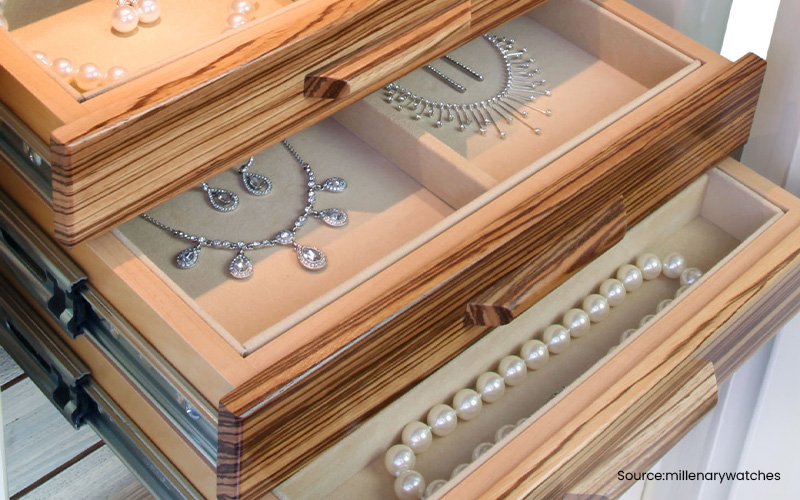
Source:millenarywatches
- Watch safe
Some individuals take an interest in watch collecting but it is a costly hobby. This renders the need to consider security measures.. A high security watch safe can better safeguard your watches than a safe deposit box at the bank. The latter may be a more tedious choice, making it inconvenient for you to access your watch collection.
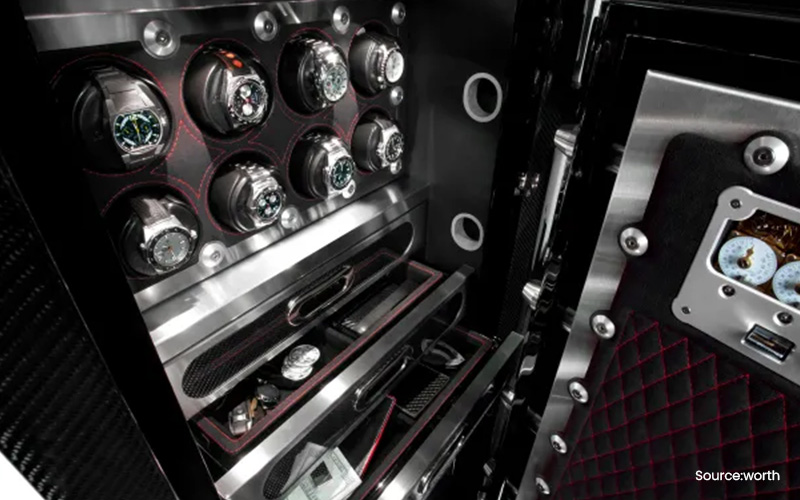
Source:worth
- Custom Safe
Every custom safe is one of a kind. It is designed to meet each owners’ specific requirements. Customising a safe may be more costly than buying an ordinary safe, depending on the features required.
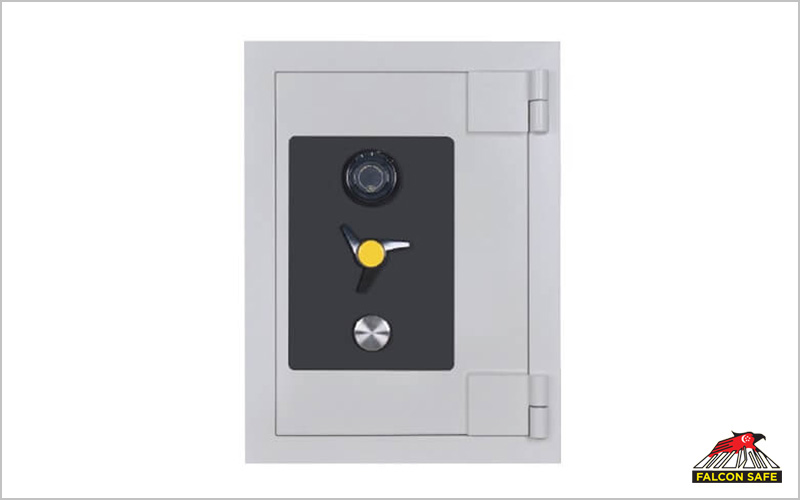
- Locking mechanism
- Time locks
You will usually see this locking mechanism in bank vaults and other high-security containers. It is a timer created to prevent the opening of the safe or vault until it reaches the preset time, despite the correct lock combination.
- Electronic code locks
This locking mechanism requires an electric current to function. It is locked and unlocked through the use of a solenoid, motor or electromagnet. Users can choose between the fail-safe or fail-secure feature. The difference? Fail-safe locks unlock automatically if the power cuts, while fail-secure locks will remain locked.
- Biometric locks
As one of the smart security devices nowadays, biometric locks usually allow vault doors to be unlocked via unconventional means like mobile app, access PIN, fingerprint, to name a few. This locking system has become more popular as it is more secure and cannot be duplicated or picked. People may misperceive that modern locking mechanisms are hard to operate. In fact, they are extremely user friendly. They work efficiently without any further maintenance after the system is programmed. Furthermore, installing biometric locks is more economical in the long run as it helps you to save up, thanks to its ability to resist extreme weather conditions, and the durability.
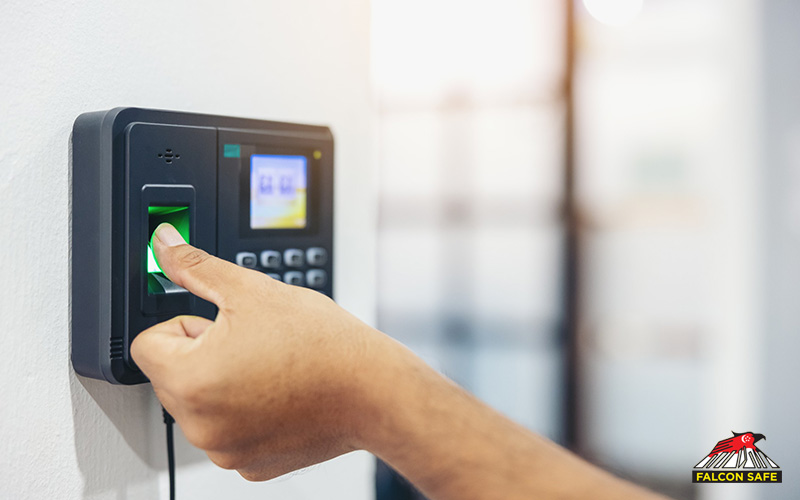
- Combination lock
Instead of using a key, this locking device requires a sequence of symbols to open. Typically, it comes with a combination dial that is connected to a spindle. You may enter the sequence through a single rotating dial that interacts with several discs or cams. This can be done through a series of several rotating discs with inscribed symbols directly linking with the locking mechanism, or through a mechanical or an electronic keypad.
- Mechanical safe locks
A mechanical safe lock works similarly as a regular locker. It can be opened by entering a combination through dial spinning. The door can be unlocked once a combination puts the lock tumblers in the right position. To open the lock, spin the dial left and right a few times to enter the right combination of code.
- Things to consider when customising a safety deposit box
A customised safety deposit box meets your security requirements better than a regular one. Here is a list of elements that you should take into consideration when ordering a custom safety deposit box:
- Consider organisation and optimisation.
- Leave some space to fit the safety deposit box.
- Make sure there is room for a fully opening door.
- Install the safety deposit box in a location that is easy to access
3.5 Questions you may have
- How much is a bank vault safe door?
The cost of a vault door is determined by the size, type and other factors.
- What should not be put in a safe deposit box?
You can keep your valuables in your safe deposit box but some items are not recommended, including spare house keys, liquid items, letters of intent and cash money.
- How secure is a bank vault?
Bank vaults are secure and hard to break into. They come with a strong vault door that requires card or voice identification. Various security measures are also in place. A bank vault has walls that are built with thick steel and reinforced concrete.
PART 4 – CONCLUSION
As technology advances with time, the security level of safes and vaults are also improving. Apart from the emergence of security technology, safe security features have been evolving as well. Thanks to this innovation, burglaries and break-ins can be combated more easily. All in all, safes and vaults should always be upgraded to enhance its capability to safeguard valuables .
Falcon Safe manufactures quality security system solutions in Singapore. We always strive to break technology boundaries for a more secure security future. Give us a call today for your peace of mind by leveraging our security integration.

